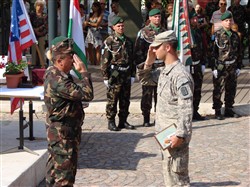3rd Air Force and Kansas Air National Guard medics train with Armenian military
Related Topics (4)
More related topics
Zarh, Armenia -- The Armenian military deployed its only rapid response medical package for the first time ever during a recent medical field training exercise. Joining them in Armenia were medical professionals from 3rd Air Force and the Kansas Air National Guard who watched the Expeditionary Medical Support (EMEDS) go up and simulated patients brought through for treatment by Armenian doctors and nurses.
"What I'm looking for is their thought process on how they're going to employ EMEDS," said Lt. Col. James Baldock, 3rd AF deputy surgeon. "And whether they can get it set up quickly and manage the entire medical system."
It's a system that's been a long time coming for the Armenian medical service. They purchased the system in 2005 and equipment started arriving one year later. After lots of hard work they were finally ready to take it into the field last month.
"It's exciting to see them finally get to this point," said Lt. Col. Tim Stevens of the Kansas Air National Guard. He was the original bilateral affairs officer who helped get the ball rolling nearly five years ago, and he made the journey all the way from Kansas to see the EMEDS in action.
"This type of asset can be quickly deployed and you can see patients right away," Colonel Stevens said. "So for me I think it's very important for the Armenian people as well as the Armenian military to have this capability."
And the Kansas Air Guard has demonstrated the importance of EMEDS. They've already deployed their system twice in real-world situations, for hurricane Katrina and following the tornado that all but destroyed the town of Greensburg, Kansas.
"So yes, we've seen firsthand what kind of impact these facilities can make," Colonel Stevens said.
That's an impact that will benefit not only Armenia, but the United States. After all, the US military also uses EMEDS. So this recent exercise helps improve interoperability between the two nations.
"If they understand how to use that and they've been practicing with it, the terminology is the same, the equipment is the same," said Maj. Dan Zablotsky of 3rd AF's International Health Division. "And they also understand how the flow of patients from point of injury to definitive care, or higher echelon care, is supposed to happen."
And that's only going to happen after lots of practice. So for three days the Armenian doctors, nurses and medical technicians not only had to put up the EMEDS, but then start treating patients who were flown in on an Armenian helicopter. Once off the medivac the patients, who had a variety of injuries, were put in an ambulance and rushed to the EMEDS. There they were triaged with the most serious cases brought in first.
EMEDS gives Armenia the capability to provide a wide range of medical services, including surgery, in the field.
Find more articles tagged with:
- National Guard
- Kansas Air National Guard
- 3rd Air Force
- training
- Armenia
- medical
- Expeditionary Medical Support
-

USACE forward engineers train with Italians
A U.S. Army Corps of Engineers Forward Engineering Support Team-Advance (FEST-A) conducted training and remote engineering missions in partnership with Italian Army Reconnaissance Engineers here September 9-21, 2012.Find more articles tagged with:
-

EUCOM senior enlisted seminar hits its mark
ISES, a weeklong U.S. European Command event held at the George C. Marshall European Center for Security Studies in Garmisch-Partenkirchen, Germany, concluded on Sept. 13.Find more articles tagged with:
-

173rd Airborne Brigade, Italian carabinieri share training, experiences
Noncommissioned officers from the rear detachment of U.S. Army Europe's 173rd Airborne Brigade Combat Team shared deployment experiences and lessons learned with Italian military law enforcement officers during cultural awareness and information operations training here, Sept. 11.Find more articles tagged with:
-

Operation Rhino Serpent 2012: US, German, British medical troops learn from one another during exercise
Operation Rhino Serpent, a multi-national medical field training exercise comprised of more than 550 U.S. Army Europe, German Armed Forces and British Armed Forces active duty Reservists and volunteersFind more articles tagged with:
-

Kansas National Guard partners with HDTC for Humanitarian Demining in Armenia
Four soldiers from the Kansas National Guard are working with a civilian representative from the U.S. Humanitarian Demining Training Center to teach international Humanitarian Mine Action standards to members of the Engineering Companies of the Armenian Peacekeeping Brigades Sept. 18-28.Find more articles tagged with:
-
Croatian president visits Exercise Jackal Stone 2012 for Media Day
President Ivo Josipovic of Croatia visited the Josip Jovic Air Base in Udbina, Croatia during the Jackal Stone 2012 Media Day to observe demonstrations from Special Operations units from 11 nations participating in this year’s training event.Find more articles tagged with:
-

World’s Largest Communication Exercise Kicks Off
Combined Endeavor 2012, the world’s largest military communications exercise, kicked off Sept. 6 at the Joint Military Training Command on U.S. Army Garrison Grafenwöhr, Germany.Find more articles tagged with:
-
USS Fort McHenry Departs Constanta, Romania
The dock-landing ship USS Fort McHenry (LSD 43) departed Constanta following the completion of Exercise Summer Storm 2012, Aug. 19.Find more articles tagged with:
-

Reliant Mermaid 2012 Draws to a Close
Exercise Reliant Mermaid 2012, between the U.S. Navy and Israeli Naval Force, concluded in Haifa, Israel, Aug. 16.Find more articles tagged with:
-

Reliant Mermaid 2012 Kicks Off
The United States Navy will participate in the regularly-scheduled Exercise Reliant Mermaid in the Mediterranean Sea, Aug. 13-16.Find more articles tagged with:













Comments: 0